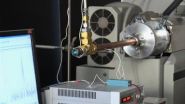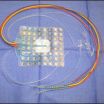(Press-News.org) RICHLAND, Wash. – A quick, accurate and highly sensitive process to reliably detect minute traces of explosives on luggage, cargo or travelling passengers has been demonstrated by scientists at the Department of Energy's Pacific Northwest National Laboratory. The vapor detection technology accurately detects and identifies the vapors of even very low-volatility explosives in real time at ambient temperature and without sample pre-concentration. Details are outlined in a recent issue of Analytical Chemistry.
Rather than searching for particle residue using a typical method like surface swipes or using pulses of air to dislodge particles for analysis, the system 'sniffs' directly for explosives vapors, much the way bomb-sniffing canines do.
"We have demonstrated direct, real-time vapor detection for the low-volatility explosive compound RDX, which is used in many types of explosives," said David Atkinson, senior research scientist at PNNL. Low-volatility compounds are those which release very small amounts of the explosive vapor typically at parts per trillion levels or lower, making it extremely difficult to detect. The PNNL system easily detects vapors from a fingerprint-sized sample of RDX at levels below 25 parts per quadrillion.
"The system correctly identified the RDX vapor using selective atmospheric pressure chemical ionization with mass spectrometry," explained Atkinson. The approach involves pulling an air sample stream and ionizing it within a reaction region in an atmospheric flow tube. The ionized sample moves to a mass spectrometer for ion detection and identification. These air samples need no heating or pre-concentrating. Analysis happens in about one second.
"The key part is ionization," said Atkinson. "We tailored the chemistry to greatly enhance both ionization efficiency and selectivity, which results in the best possible detection."
Only a limited number of ultra-sensitive detection methods have been found capable of detecting low-volatility explosive compounds at levels below parts-per-trillion. But these methods typically take much longer and require pre-concentration of the sample from the vapor phase.
Currently, most airport security agents use cloth-like material to swipe luggage and cargo to collect explosives particles for detection. The samples are then analyzed one at a time in a process that requires the swipe to be heated to a temperature needed to volatilize the particles for detection.
In some cases, airport security will turn to canines for detection, especially for large items where size such as vehicles or cargo make particle sampling impractical.
"What we are attempting to develop is an instrument that replicates or surpasses the capabilities of a dog," said Atkinson. However, while canine olfactory systems are highly developed, dogs present issues that machines don't. Man's best friend only works limited hours, must be fed, exercised regularly and rested. While a dog's ability to smell and detect explosives is extremely sensitive, instruments may soon surpass their capabilities and perform at a lower cost.
Robert Ewing, PNNL senior research scientist, sees a bright future for the technology and is hoping to push the performance even further.
"Currently we have demonstrated the detection of explosive compounds such as RDX, PETN, nitroglycerine and tetryl, along with plastic explosives that contain these materials at low parts per quadrillion levels," said Ewing. "Future research will focus on detecting other explosive threats by manipulating the ionization chemistry and lowering detection limits."
INFORMATION:
PNNL's vapor detection technology is part of the lab's Initiative for Explosives Detection, which has received financial support from the Laboratory Directed Research and Development program at PNNL.
Interdisciplinary teams at Pacific Northwest National Laboratory address many of America's most pressing issues in energy, the environment and national security through advances in basic and applied science. PNNL employs 4,500 staff, has an annual budget of nearly $1 billion, and has been managed for the U.S. Department of Energy by Ohio-based Battelle since the laboratory's inception in 1965. For more information, visit the PNNL News Center, or follow PNNL on Facebook, LinkedIn and Twitter.
Video demonstration available at -- http://www.youtube.com/watch?v=29ZYhxpfTQA
Explosives vapor detection technology: The new 'sniff test'
Method focuses on direct, real-time vapor detection rather than collection of explosives particles; could change paradigm for explosives screening
2013-02-21
ELSE PRESS RELEASES FROM THIS DATE:
Science synthesis to help guide land management of nation's forests
2013-02-21
ALBANY, Calif.—A team of more than a dozen scientists from the U.S. Forest Service's Pacific Southwest (PSW) and Pacific Northwest research stations, universities and Region 5 Ecology Program recently released a synthesis of relevant science that will help inform forest managers as they revise plans for the national forests in the Sierra Nevada and southern Cascades of California. The three most southern national forests in the Sierra Nevada—Inyo, Sequoia and Sierra—will be among the first of the 155 national forests to update their management plans. The new planning rule ...
Cooling may prevent trauma-induced epilepsy
2013-02-21
In the weeks, months and years after a severe head injury, patients often experience epileptic seizures that are difficult to control. A new study in rats suggests that gently cooling the brain after injury may prevent these seizures.
"Traumatic head injury is the leading cause of acquired epilepsy in young adults, and in many cases the seizures can't be controlled with medication," says senior author Matthew Smyth, MD, associate professor of neurological surgery and of pediatrics at Washington University School of Medicine in St. Louis. "If we can confirm cooling's effectiveness ...
The brainless origin of our head
2013-02-21
In many animals, the brain is located in a specific structure, the head, together with sensory organs and often together with the mouth. However, there are even more distantly related animals, which have a nervous system, but no brain, like sea anemones and corals.
In this collaborative study between a research group led by Fabian Rentzsch (Sars Centre Bergen) and Ulrich Technau from the Dept. of Molecular Evolution and Development the sea anemone Nematostella vectensis was used to find out if one of the ends of the sea anemone corresponds to the head of higher animals. ...
Aspirin and omega-3 fatty acids work together to fight inflammation
2013-02-21
Experts tout the health benefits of low-dose aspirin and omega-3 fatty acids found in foods like flax seeds and salmon, but the detailed mechanisms involved in their effects are not fully known. Now researchers reporting in the February 21 issue of the Cell Press journal Chemistry & Biology show that aspirin helps trigger the production of molecules called resolvins that are naturally made by the body from omega-3 fatty acids. These resolvins shut off, or "resolve," the inflammation that underlies destructive conditions such as inflammatory lung disease, heart disease, ...
Why living against the clock is a risky business
2013-02-21
Living against the clock—working late-night shifts or eating at inappropriate times, for example—can come with real health risks, metabolic syndrome, obesity, and diabetes among them. Now, researchers reporting in Current Biology, a Cell Press publication, on February 21 have new evidence to explain why it matters not just what mice (or by extension, people) eat, but also when they eat it.
Insulin action rises and falls according to a 24-hour, circadian rhythm, the researchers found. What's more, mice unable to keep the time for one reason or another get stuck in an insulin-resistant ...
For monarchs to fly north, first they've got to chill
2013-02-21
Monarch butterflies are well known for their ability to fly 2,000 miles south from North America to Mexico each fall and back again in the spring. Now, researchers reporting in Current Biology, a Cell Press publication, on February 21 have evidence to show that the butterflies would just keep on heading south if it weren't for the chilly weather.
The findings help to explain why the butterflies spend the winter on frosty mountaintops. They also imply that global climate change could profoundly influence the monarchs' migrations, the researchers say.
"The monarchs need ...
Biomarker may identify neuroblastomas with sensitivity to BET bromodomain inhibitors
2013-02-21
PHILADELPHIA — Neuroblastoma, the most common malignant tumor of early childhood, is frequently associated with the presence of MYCN amplification, a genetic biomarker associated with poor prognosis. Researchers have determined that tumors containing MYCN amplification are sensitive to a new class of drugs, BET bromodomain inhibitors.
The researchers made this discovery in a preclinical study, which was funded in part by a Stand Up To Cancer Innovative Research Grant and was published in Cancer Discovery, a journal of the American Association for Cancer Research.
"BET ...
Life's tiniest architects pinpointed by Yale researchers
2013-02-21
If a genome is the blueprint for life, then the chief architects are tiny slices of genetic material that orchestrate how we are assembled and function, Yale School of Medicine researchers report Feb. 21 in the journal Developmental Cell.
The study pinpoints the molecular regulators of epigenetics – the process by which unchanging genes along our DNA are switched on and off at precisely right time and place.
"Our genome is like a landscape with lakes, mountains, and rivers, but it is not yet a community or a city full of buildings," said Haifan Lin, director of the ...
Research shows that coldness triggers northward flight in migrating monarch butterflies
2013-02-21
WORCESTER, MA – Each fall millions of monarch butterflies from across the eastern United States begin a southward migration in order to escape the frigid temperatures of their northern boundaries, traveling up to 2,000 miles to an overwintering site in a specific grove of fir trees in central Mexico. Surprisingly, a new study by scientists at the University of Massachusetts Medical School published in Current Biology, suggests that exposure to coldness found in the microenvironment of the monarch's overwintering site triggers their return north every spring. Without this ...
New study indicates avocado consumption may be associated with better diet quality
2013-02-21
IRVINE, Calif. (February 20, 2013) – New analysis of data from the National Health and Nutrition Examination Survey (NHANES) , a program of the Centers for Disease Control and Prevention (CDC), indicates that consuming avocados may be associated with better diet quality and nutrient intake level, lower intake of added sugars, lower body weight, BMI and waist circumferences, higher "good cholesterol" levels and lower metabolic syndrome risk. These results were published in the January 2013 issue of Nutrition Journal.
Specifically, the survey data (NHANES 2001-2008, ...
LAST 30 PRESS RELEASES:
New study highlights link between eviction rates and gun violence
Heatwaves heat up soil but not toxin levels in rice, study finds
Digital modeling reveals where construction carbon emissions really come from
Turning farm waste into water filters
New study shows how the spleen helps the immune system accept a transplant
New Mayo Clinic study advances personalized prostate cancer education with an EHR-integrated AI agent
Researchers identify novel therapeutic target to improve recovery after nerve injury
Microbes in breast milk help populate infant gut microbiomes
Reprogramming immunity to rewrite the story of Type 1 diabetes
New tool narrows the search for ideal material structures
Artificial saliva containing sugarcane protein helps protect the teeth of patients with head and neck cancer
Understanding the role of linear ubiquitination in T-tubule biogenesis
Researchers identify urban atmosphere as primary reservoir of microplastics
World’s oldest arrow poison – 60,000-year-old traces reveal early advanced hunting techniques
Bristol scientists discover early sponges were soft
New study uncovers how rice viruses manipulate plant defenses to protect insect vectors
NSF–DOE Vera C. Rubin Observatory spots record-breaking asteroid in pre-survey observations
Ribosomal engineering creates “super-probiotic” bacteria
This self-powered eye tracker harnesses energy from blinking and is as comfortable as everyday glasses
Adverse prenatal exposures linked to higher rates of mental health issues, brain changes in adolescents
Restoring mitochondria shows promise for treating chronic nerve pain
Nature study identifies a molecular switch that controls transitions between single-celled and multicellular forms
USU chemists' CRISPR discovery could lead to single diagnostic test for COVID, flu, RSV
Early hominins from Morocco reveal an African lineage near the root of Homo sapiens
Small chimps, big risks: What chimps show us about our own behavior
We finally know how the most common types of planets are created
Thirty-year risk of cardiovascular disease among healthy women according to clinical thresholds of lipoprotein(a)
Yoga for opioid withdrawal and autonomic regulation
Gene therapy ‘switch’ may offer non-addictive pain relief
Study shows your genes determine how fast your DNA mutates with age
[Press-News.org] Explosives vapor detection technology: The new 'sniff test'Method focuses on direct, real-time vapor detection rather than collection of explosives particles; could change paradigm for explosives screening




